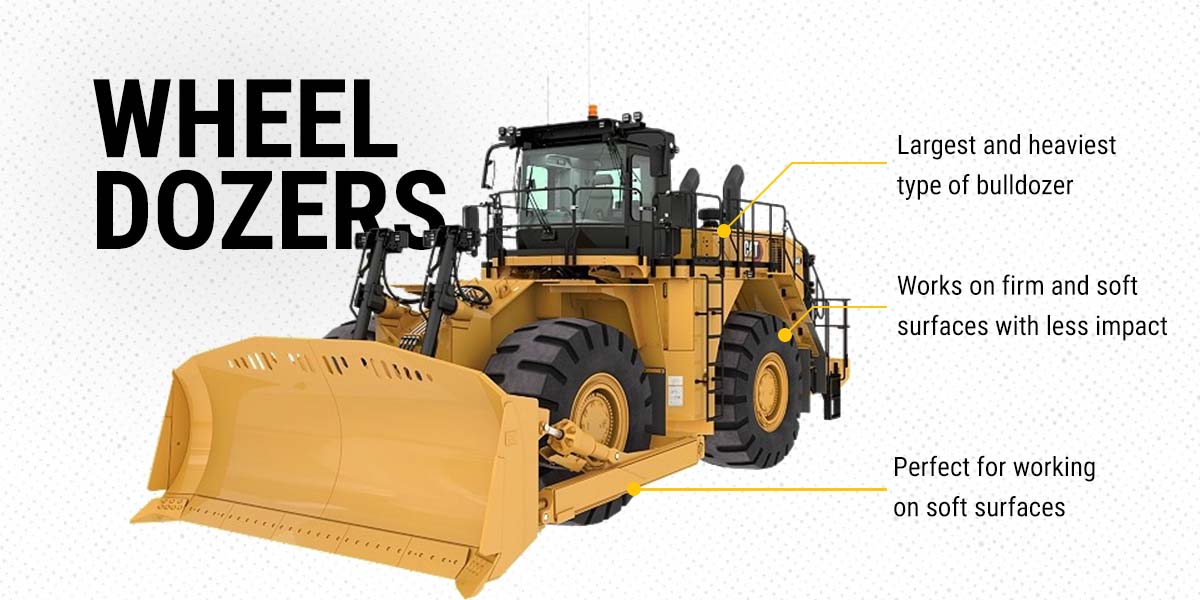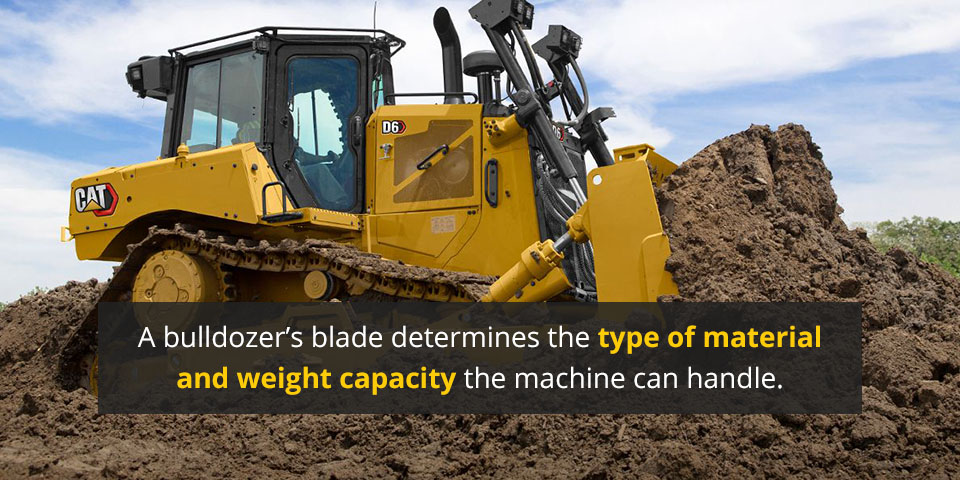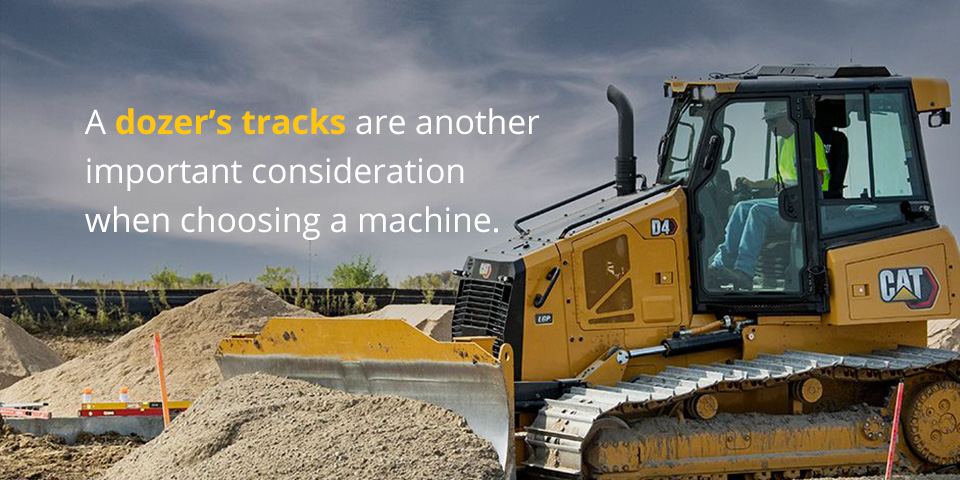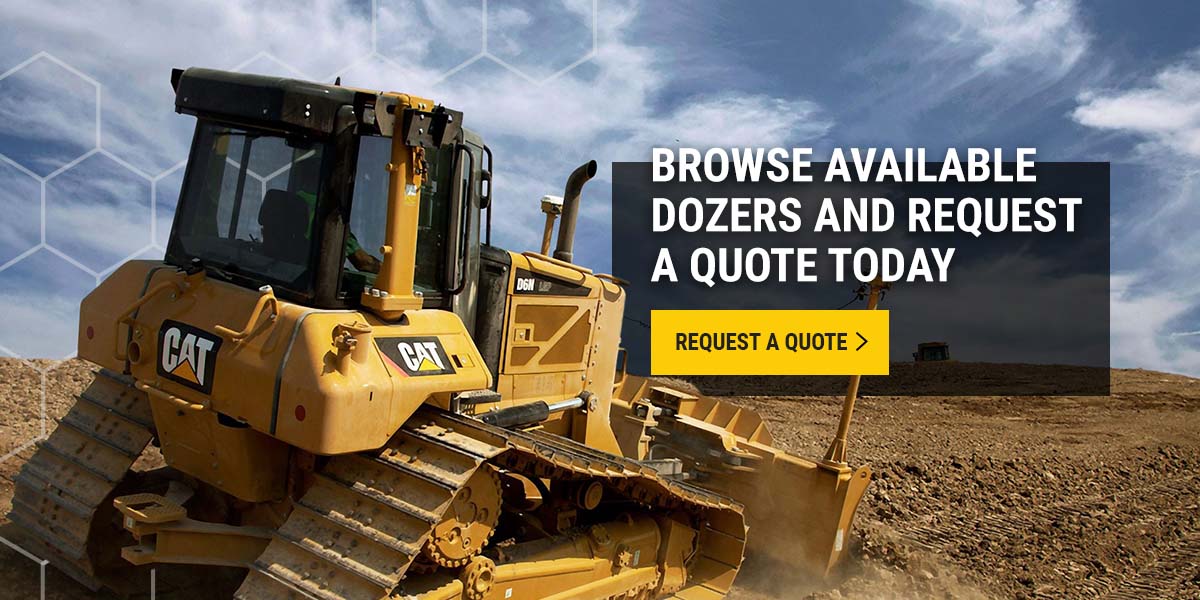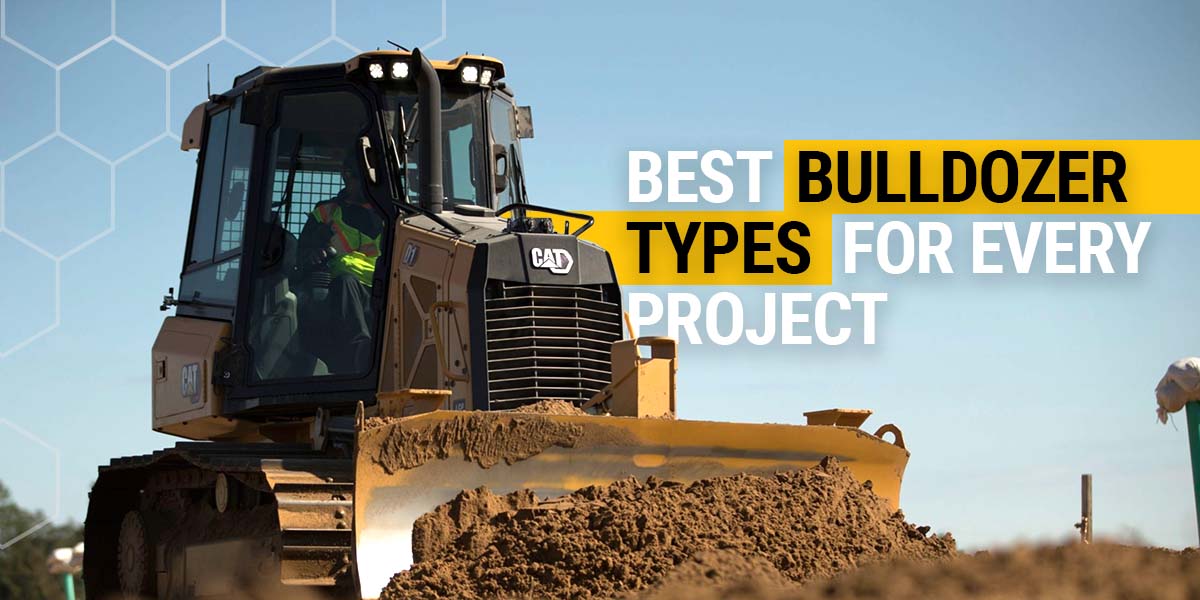
Bulldozers differ in size, capabilities, features, attachments, and application. Choosing the right bulldozer for each job is crucial for project results and efficiency. Before purchasing or renting a bulldozer, it’s important to consider the tasks you perform and the type of land you work on.
Top 6 Types of Bulldozers
To determine the best option for your fleet, weigh the pros and cons of how each type of dozer works. Consider the following different types of bulldozers and how they differ so you can get the job done.
1. Crawlers
A crawler is a heavy-duty bulldozer that operates on tracks. It’s also known as a track bulldozer and contains a heavy plate, allowing it to load and push heavy materials and objects. Crawlers are the most common type of dozer, and they are exceptionally versatile. Traction enables them to traverse irregular and dense terrain, and larger crawlers feature rippers that can help break and clear thick ground.
A crawler is the best type of bulldozer for the following applications:
- Leveling roads
- Clearing land to prepare for new construction
- Mining
- Projects requiring crews to move large amounts of materials
- Moving heavy objects and materials
- Scraping fire breaks to prevent wildfires from reaching homes and businesses
2. Mini Dozers
A mini or compact bulldozer is smaller than other models, making it perfect for residential projects. It operates on tracks and offers excellent power, but it’s small enough to fit in tight spaces. You can transport it using a standard trailer and maneuver it with ease. Its small size also allows you to operate it at faster speeds than other bulldozers.
Mini dozers are ideal for the following tasks:
- Grading
- Clearing land
- Pushing snow
- Sloping
- Back-filling
- Working in any type of residential or confined commercial area
3. Wheel Dozers
A wheel dozer is the largest and heaviest type of bulldozer, and some people refer to it as a tire bulldozer. It’s a larger and more powerful machine that can help crews complete large projects efficiently. It operates on wheels instead of tracks so it can work on firm and soft surfaces with less impact. Wheel dozers are perfect for working on soft surfaces such as turf and sand.
The axis and turning radius are smaller on a wheel dozer than on a crawler dozer, allowing crews to handle it easily. It also features articulated hydraulic steering for greater maneuverability.
A wheel dozer is the best option for high-performance construction jobs like:
- Highway construction
- Mining
- Leveling
- Building large structures such as sports stadiums and water parks
4. Mulcher Dozers
These types of bulldozers are best for clearing land with a lot of vegetation. The mulching attachment can shred, grind, and clear large pieces of land with ease. Mulcher dozers can clear bushes, shrubbery, and even trees for land development projects. The mulcher attachment also acts as a wood chipper to grind vegetation into smaller pieces for easy clearing and disposal.
A mulcher dozer is best suited for the following projects:
- Land clearing for agriculture
- Forestry and logging operations
- Infrastructure maintenance
- Wildfire prevention
- Utility line installation
- Natural disaster cleanup
- Trail and recreational area development
- Landscaping projects
5. Hybrid Dozers
Hybrid bulldozers combine traditional diesel engines with electric components, enhancing efficiency and reducing environmental impact. These machines perform earthmoving tasks, such as grading and excavation. In this dual-power system, the electric components provide an extra boost. The regenerative braking converts kinetic energy into electrical power.
The ability to switch between power sources is a feature unique to this type of bulldozer, which can optimize performance based on workload. This dozer particularly excels in urban construction projects where emission control is crucial. Its versatility also makes it well-suited for various terrains.
A hybrid dozer is an ideal option for projects like:
- Urban infrastructure development
- Residential construction
- Commercial building sites
- Municipal projects and maintenance
- Mining operations
- Smart city initiatives
6. Shiphold Dozers
Shiphold dozers are designed for maritime environments and play a critical role in handling cargo within a cargo ship. These bulldozers are specialized in moving efficiently in a confined ship. They are made to organize goods and optimize cargo loading and unloading operations. One of their key features is their corrosion resistance, which allows them to withstand marine environments.
This is a different type of bulldozer because it is made to be compact and operate in specific conditions. They are compact to fit into cargo holds within ships. Shiphold dozers are adaptable to the various challenges posed by ship interiors and ensure material handling can be optimized at all times.
Shiphold dozers are made to handle these specific tasks:
- Arranging cargo on ships
- Maintain efficient cargo flow in maritime logistics
- Loading and unloading cargo
- Maneuvering on moving ships
Bulldozer Blade Types
When choosing a bulldozer for an upcoming job, it’s important to consider blade types. The blade is responsible for digging through and pushing materials, and the right type can increase efficiency. A bulldozer’s blade determines the type of material and weight capacity the machine can handle. Consider the following kinds of bulldozer blades.
Universal Blade
Universal blades or U-blades are curved and contain side wings to keep material contained while the bulldozer moves. A universal blade is the tallest and widest type of blade, and it’s the best option if you need to push material across a long distance. It’s also good for working with medium- or soft-density soil.
Straight Blade
Straight blades or S-blades are the shortest type of dozer blade. While they lack side wings, their shape enables them to handle hard-density, medium-density, and fine-grained materials. While the straight blade has limited carrying and lifting capabilities, it’s an excellent choice for leveling soil, back-filling, grading, and stumping applications.
Semi-U Blade
A semi-U or S-U-blade combines a U-blade and S-blade for greater versatility and strength. Its shape is similar to the U-blade but with smaller side wings, less curve, and a narrower shape. The S-U-blade is a great option for pushing materials across long distances, and it offers more penetration strength than the U-blade. It works well on medium- or soft-density soil and sand.
The S-U-blade works best for applications like:
- Ditching
- Moving heavy materials
- Crowning
- Stumping
Angle Blade
An angle blade is also known as a two-way blade, and it has angling abilities because of its attachment to the center of a bulldozer panel. It can angle to the right or left in order to move materials to the side as it moves. Since there are no side wings, it’s easy for material to spill out using an angle blade. Even so, it’s a great option for working with gravel, snow, and soils of all density levels.
The angle blade works well for tasks such as:
- Ditching
- Shaping
- Stripping
- Stumping
Power-Angle-Tilt Blade
A power-angle-tilt or PAT blade is highly versatile. As the name suggests, it offers lifting, angling, and tilting abilities for better maneuverability. Since a PAT blade can move in all directions, it’s ideal for:
- Grading
- Leveling
- Back-filling
- Land clearing
Types of Bulldozer Tracks
A dozer’s tracks are another important consideration when choosing a machine. A bulldozer can have one of the following two types of tracks:
- High-tread: High-tread tracks are elevated above the ground and have higher traction. High-tread tracks are ideal for working on tougher terrain or sloped surfaces.
- Low-tread: Low-tread tracks move at ground level and are best for level surfaces.
Types of Bulldozer Track Treads
Bulldozer track treads vary in design for different applications. Common types of bulldozer track treads include:
- Grousers: Grousers, or cleats, are protruding metal fittings on bulldozer tracks that enhance traction. They also prevent slippage when working on difficult terrain.
- Flat bar treads: Flat bar treads are straight metal bars placed across the tracks. They provide a smooth surface, optimizing ground contact and facilitating stable movement. This is an ideal track tread to use in less demanding terrains.
- Combination treads: These treads use a hybrid design featuring cleats and flat bars. This combination provides a versatile solution for balancing, traction, and a smoother ride across various surfaces.
- Pyramid treads: This tread pattern resembles a series of pyramids and provides bulldozers with enhanced grip. Pyramid treads work on a variety of different surfaces and enhance overall stability and performance.
Browse Available Dozers and Request a Quote Today
Selecting the right bulldozer and blade for a specific project increases efficiency and helps ensure optimal results. Thompson Tractor offers a wide selection of bulldozers for various applications, allowing you to choose the ideal machine for every job.
We distribute Cat® dozers to provide the highest quality machines for the toughest jobs. Whether you need to purchase a bulldozer for your fleet or rent a machine, Thompson Tractor can help. Contact us to request a quote and learn more about finding the right dozer for your next project.

